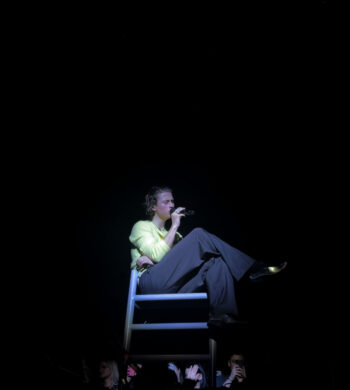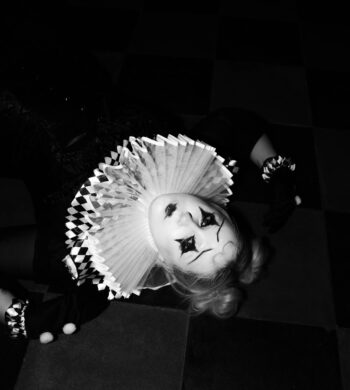Am 14. February stand ich im Orpheum in Graz, mitten unter den Menschen, als Berq anfängt zu singen und ich einen Klanglicht Flashback bekam. Eine LED-Stange, zurückhaltend, minimalistisch, aber mit Maximum an Effekten. Genau so etwas nutzten wir damals im Oktober in unserer Installationsarbeit. Ich konnte mir nicht helfen und lachte laut. Es war dieser Moment, in dem alles zusammenkam: Das, was ich mir früher einfach nur angesehen hatte, verstehe ich jetzt technisch und konzeptionell. Ich weiß jetzt, wie man so etwas macht – und könnte es selbst umsetzen.
Früher hätte ich nur die Visuals in Staunen bestaunt, jetzt sehe ich sie anders. Ich merke mir die Technik danach, die Logik des Lichtmanagements, die Effektivität von kleinen Details. Es ist nicht mehr dieses zauberhafte „Wie haben sie das gemacht?“, sondern ein „Easy, mach ich dir“. Und genau das ist wie ein richtiger Schritt voran.
Kunst und Technik vermischen sich auf eine neue Weise, wenn man einen Schritt mehr hinterher weiß. Und das ist es gerade, was mir in diesem Moment gezeigt wurde: Ich bin nicht mehr allein Zuschauerin – ich bin jemand, der es selbst tun kann.
Schlagwort: Klanglicht
#2 Impuls: Clowning around Town
Die Idee war es ein Fotoshooting durchzuführen, bei dem die, von unserer Gruppe entwickelte, Lichtinstallation in Szene gesetzt wird. Ein Harlequin-Kostüm diente als zentrale Figur, um die surreale Thematik des diesjährigen Klanglicht-Themas „Dreams“ zu verkörpern. Zudem wird durch das Kostüm das Zusammenspiel von Licht und Schatten in den Kirchenräumen betont. Der Harlequin symbolisiert die Verschmelzung von Gegensätzen – ein Motiv, das durch die Dynamik von Helligkeit und Dunkelheit, die unsere Lichtinstallation erzeugt, verstärkt wird.
Das Ziel des Projekts war es, die besondere Atmosphäre der Antoniuskirche in Verbindung mit der Lichtinstallation einzufangen und diese als zentrales visuelles Element hervorzuheben. Das Konzept verbindet die historische und spirituelle Aura der Kirche mit modernen, künstlerischen Effekten, die durch gezielte Lichtregie zum Leben erweckt werden. Gleichzeitig soll das Projekt das visuelle Potenzial der Installation in Verbindung mit dem übergeordneten Thema „Dreams“ (Spektrum) künstlerisch untermalen.
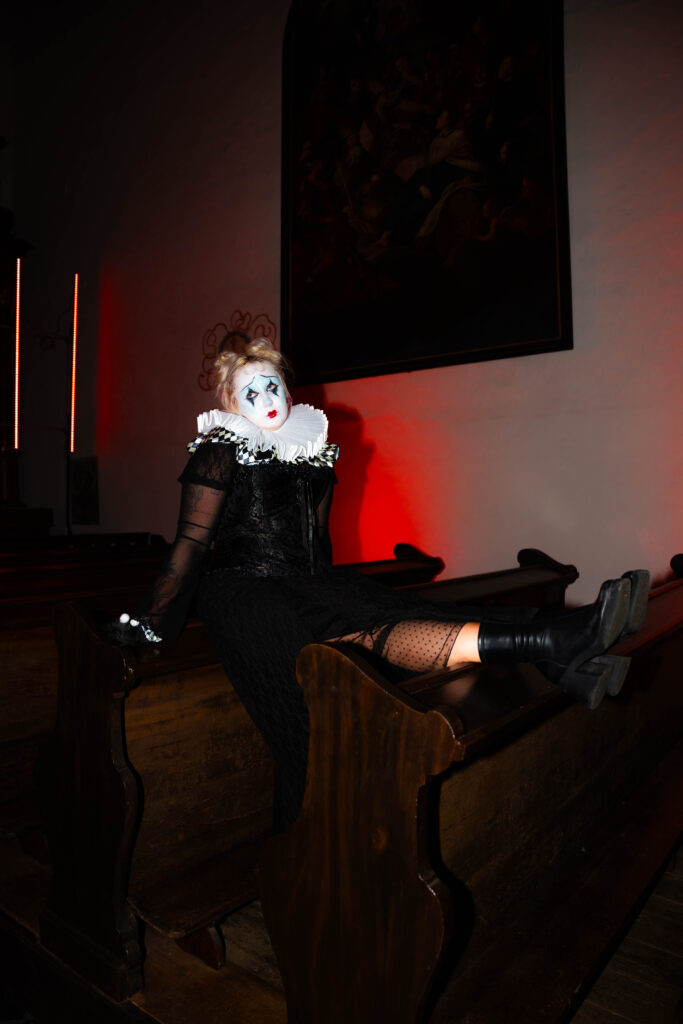
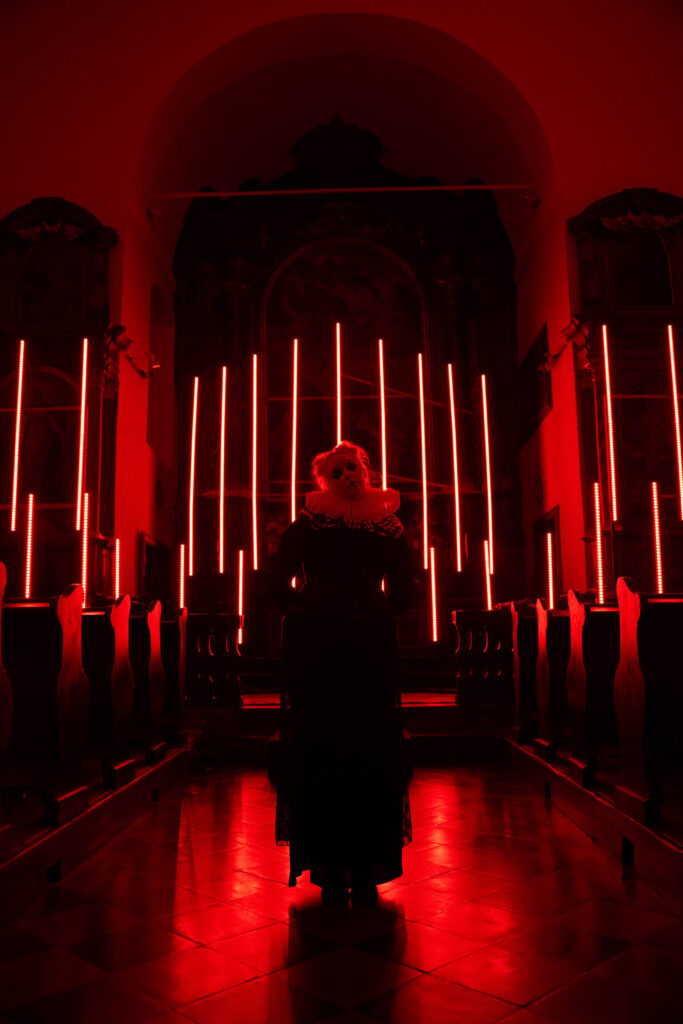
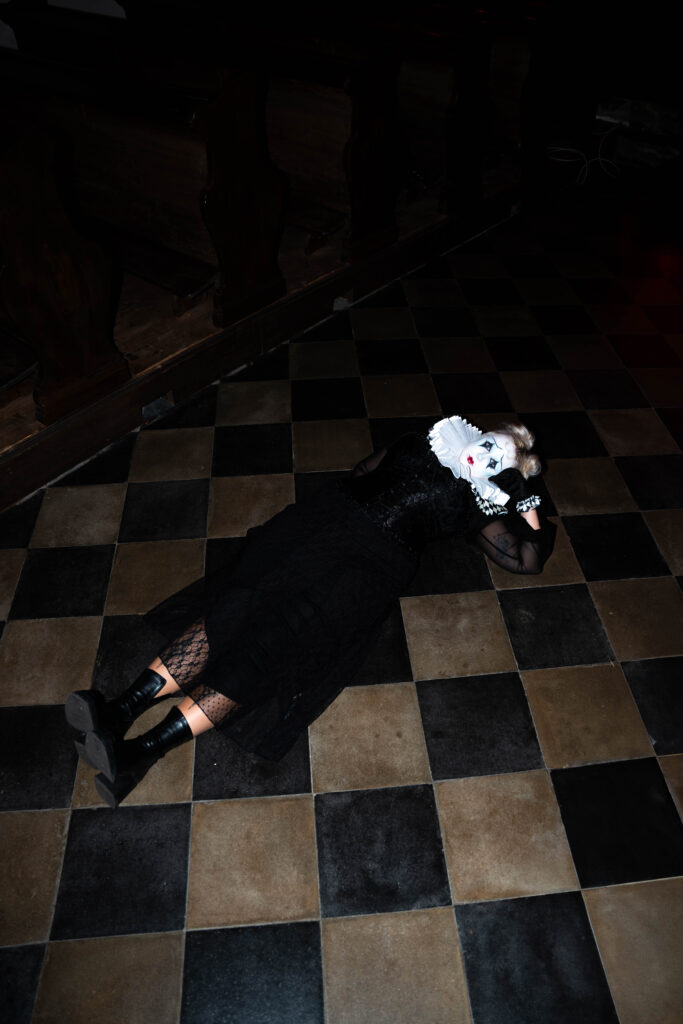

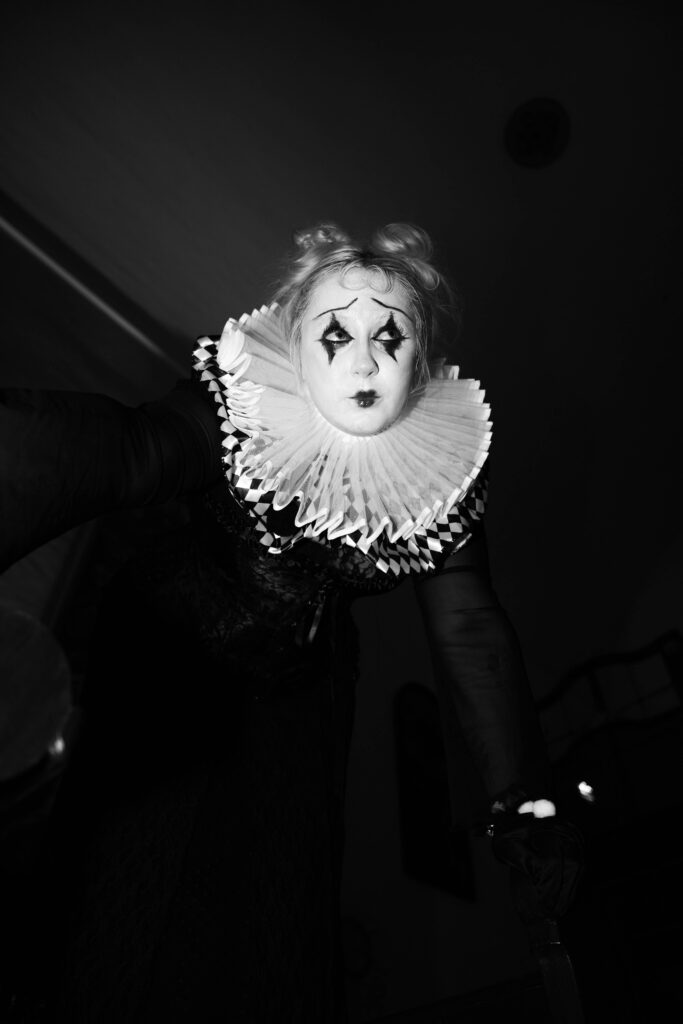
Konzept, Idee: Lea Haas
Fotografien: Stefanie Weber
IMPULSE #7: Klanglicht
Vom 24. bis 26. Oktober 2024 verwandelte sich die Grazer Innenstadt in ein strahlendes Gesamtkunstwerk, das die Magie von Licht und Klang auf eindrucksvolle Weise zelebrierte. Unter dem diesjährigen Motto „Welten der Träume“ luden nationale und internationale Künstler:innen dazu ein, surreale und poetische Räume zu erkunden. Zwischen glitzernden Installationen auf dem Schlossberg, poetischen Lichtspielen im Joanneumsviertel und faszinierenden Klangwelten rund um Oper und Schauspielhaus verschmolzen Kunst und Publikum zu einer gemeinsamen Traumwelt. Rund 105.000 Besucher:innen wurden in eine Vielfalt von Stimmungen und Fantasien entführt, die sie staunen, nachdenken und träumen ließen.
Brücke zur Masterarbeit – Emotion und Interaktion
Obwohl „Klanglicht 2024“ ein künstlerisches Festival ist, zeigte es zahlreiche Parallelen zu meinem Masterarbeitsthema User-Involvement im Branding. Die Installationen luden die Besucher:innen ein, aktiv teilzunehmen, sich emotional einzulassen und die Kunst auf individuelle Weise zu interpretieren.
Diese Aspekte – die Schaffung einer Verbindung zwischen Werk und Publikum, die Betonung von Interaktivität und die Inszenierung von Emotionen – sind ebenfalls zentrale Bestandteile von User-Involvement in der Markenführung. Das Festival verdeutlichte eindrucksvoll, wie bedeutungsvoll es ist, Menschen nicht nur als passive Betrachter:innen, sondern als aktive Mitgestalter:innen einzubeziehen.
Erkenntnisse und Impulse für die Masterarbeit
Der Besuch von „Klanglicht 2024“ hat mir wertvolle Einblicke vermittelt, die direkt in meine Masterarbeit einfließen können:
- Emotionale Inszenierung: Die Installationen zeigten, wie Licht und Klang eingesetzt werden können, um starke emotionale Verbindungen zu schaffen. Im Branding können ähnliche Prinzipien genutzt werden, um Produkte und Marken erlebbar zu machen.
- Interaktive Formate: Viele der Installationen forderten die Besucher:innen auf, mit ihrer Umgebung zu interagieren. Diese Interaktivität verstärkte das Engagement und könnte eine zentrale Rolle bei der Entwicklung meiner App spielen, um User-Involvement zu fördern.
- Individuelle Interpretationen: Jede:r Besucher:in erlebte „Klanglicht“ auf einzigartige Weise. Dies unterstreicht, wie wichtig es ist, Flexibilität und Personalisierung in Interaktionen zu ermöglichen – ein Ansatz, der auch im digitalen Branding eine große Rolle spielt.
- Verbindung von Sinn und Ästhetik: Die Installationen verbanden ästhetische Schönheit mit tiefgründigen Botschaften. Marken können davon lernen, indem sie emotionale Erlebnisse mit relevanten Werten und authentischen Geschichten verknüpfen.
„Klanglicht 2024“ war für mich ein beeindruckendes Erlebnis, das gezeigt hat, wie stark Kunst uns berühren und mitreißen kann. Besonders die Verbindung von Licht, Klang und Interaktion hat mich inspiriert und mir neue Perspektiven eröffnet.
Für meine Masterarbeit nehme ich mit, wie wichtig es ist, Menschen aktiv einzubeziehen und ihnen Raum für eigene Interpretationen zu geben. Diese Erfahrungen motivieren mich, weiter an kreativen Ansätzen zu arbeiten, um Interaktion und Emotion auch im Branding spürbar zu machen.
Weitere Literatur:
- Emotional Branding : How Successful Brands Gain the Irrational Edge von Daryl Travis
- Experiential Marketing: How to Get Customers to Sense, Feel, Think, Act, Relate von Bernd H. Schmitt
- Storytelling for User Experience von Whitney Quesenbery & Kevin Brooks
→ Impulse_01 | Klanglicht
Klanglicht 2024 was both challenging and exciting for me. Having the chance to showcase two projects, I experienced some of the most rewarding but also stressful moments throughout the process. We presented Sonolux Speculative Future in the Young Masters exhibition with Mahtab Jafarzadeh Miandehi, Hannah Albrecht, Francisco Sylla, and David Laßlberger, and Langnicht as part of Spektrum. Klanglicht festival is such an inspiring event for me and my thesis, featuring installations that combine sound and visuals in creative ways.
SONOLUX SPECULATIVE FUTURE
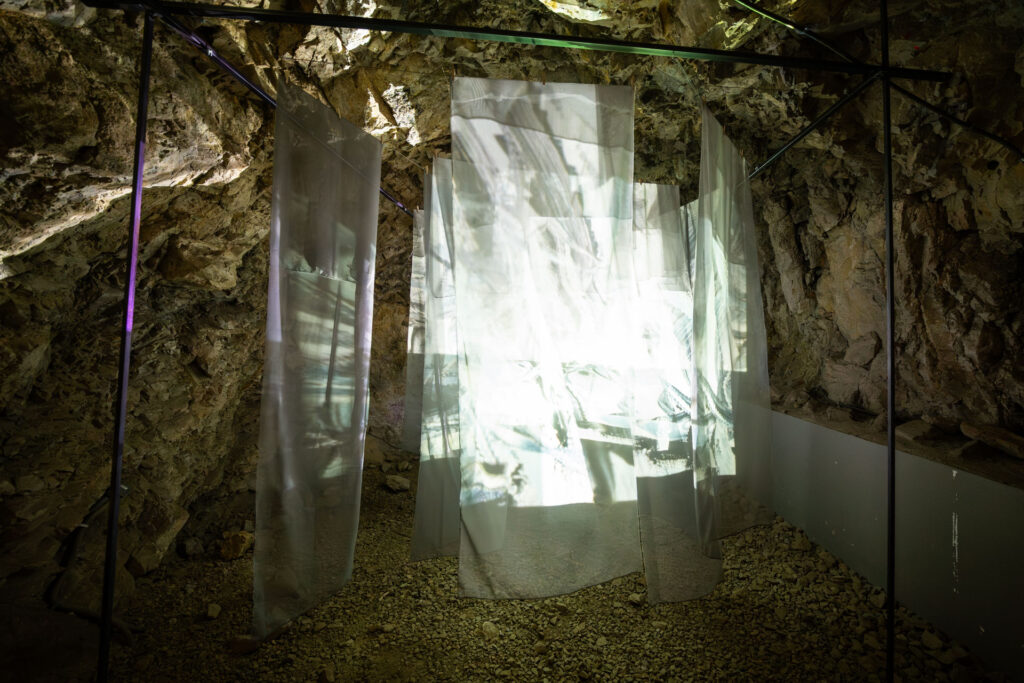
For this project, we created a multi-sensory installation inspired by research into the acoustic ecology of the Hilmteich area in Graz. It explored how urbanization—like the construction of the LKH hospital—impacts this natural space. We imagined speculative futures for Hilmteich, showing two scenarios while reflecting on its current state. This installation was featured in the Young Masters exhibition at Schlossbergstollen.
David and I worked on audio-reactive visuals using TouchDesigner, which was a great way to practice my skills and showcase them in an exhibition. On top of that, we all worked together to construct the installation, which made the whole experience even more challenging but good 🙂
Being part of Young Masters was truly amazing. I’m really proud of our team and what we did!
SPEKTRUM
For Spektrum, we transformed the nave of Antoniuskirche in Graz into an immersive media experience. The title reflects the exploration of light and sound spectra, as well as the broader concepts of diversity and range. Our narratives focused on the in-betweens—like emotional and meaning spectra, harmony and chaos, colors and movement.
This was made possible with the guidance of our amazing lecturers: Astrid Drechsler, Daniel Fabry, Michael Kernbichler, Didi Mosbacher, and Roman Pürcher.
LANGNICHT
Langnicht explores the spectrum between nature and technology. The entire process—from planning to building to the final presentation—was such a mix of excitement, learning, and occasional stress. Our team grew so much during this time, and we created something we’re all really proud of. For me, working with After Effects and contributing to the construction was especially inspiring.
Conclusion
I feel really proud and lucky to have been part of Klanglicht 2024! It was an amazing experience to not only showcase our work but also to see and connect with other artists, exchange ideas, and receive feedback from professionals from the field of design. All the hard work, stress, and long hours were absolutely worth it. I’m so grateful for this opportunity and everything I’ve learned along the way! ✨💙
Overall,
Impulse 01 // Klanglicht
Over the past two semesters of researching Calm Technology, I have begun to focus more and more on Human-Computer Interaction (HCI) and how to align it with the principles of Calm Technology to combat the negative effects of the digitalisation of our environment. My goal is to create or change the converter of digital interactions to make them materialise the digital in a more natural way. In my opinion, this can only be done by changing the way, mode and nature of the interactions we currently have with the digital world. So I will try to get impulses in different human-computer interactions and how a calmer materialisation of the digital can be achieved. My first impulse for this is the Klanglicht festival in Graz, as it also partly explores ways of communicating complex information, feelings or stories with the reduced methods of only using sound and light. This happened from two perspectives, one as a visitor and one as a participant in the installation Spektrum of the FH Joanneum.
Klanglicht
From the perspective of a visitor to Klanglicht, it was interesting to see in how many different ways different artists were able to communicate or convey sometimes quite complex stories, emotions or meanings without using traditional storytelling media such as screen or spoken or written text. Only by using sound, light and in some cases movement were they able to convey all this in a clear way. This was achieved by abstracting all the elements of communication between the installation and the visitor and placing them in the right context. Calm Technology aims to do just that, moving away from attention-grabbing push notifications and messages to more natural and contextual interactions that are less overwhelming for the user. This can be achieved by using movement or lights in the periphery of the vision, or by using sounds that convey secondary information in context. This was demonstrated in a more artistic but nonetheless true way by the projects exhibited at Klanglicht. One installation called ENDERS / surface by Boris Acket was particularly inspiring on this theme. The way in which he achieved an almost natural and very calming environment using only fairly technical elements such as motors and stage lighting, and using these elements to create an interplay of shadow and light with subtle movement, was an impressive example of how technology can be used to create something calm and detached from its digital parts. The unpredictable but harmonious movement of the fabric mirrors natural phenomena such as the ripple of water or the wind through grass, creating a sense of calm and connection with the environment. The mirroring of familiar, natural patterns can be a key factor in making human-computer interactions more ambient and enjoyable. By orienting these interactions around the rhythms and behaviours of our natural world, rather than the rigid structures of digital systems, we can create ambient interaction that feel more intuitive and calming. By using our learned understanding of natural behaviours instead of us having to learn new and unnatural patterns and behaviours.
Langnicht
As participants the impulse of Klanglicht was more practical than as visitors. Together with all four majors of our study programme (Communication, Media, Sound & Interaction) we had the opportunity to realise our own sound & light installation under the theme Spektrum in the Antoniuskirche in Graz. The first challenge was to set up the installation inside the church, where we were not allowed to change anything and everything had to be self-supporting as the building is a listed building. But after a few rounds of trial and error and many hours of work, we managed to create a rather impressive and complex installation. As shown in the video below. This first challenge taught me a lot about how to structure projects, how to prioritise tasks and that the more work you do in the background, the smoother and better the experience at the front. The second challenge was to create a three-minute sound and light show to be played on the installation, now in smaller interdisciplinary groups of 5-6 students. Our chosen story for this show was the specter of nature and technology, how they contradict each other, but can also find common ground in a utopian solar punk vision. To convey this message we had only the medium of spatial sound and the construction of LED pixel rails with individual LED dots rather than an LED screen. The learning experience here was how to abstract a message so that it would only work if you heard sounds and saw light dots glowing in an abstract pattern, without losing any of its meaning. In the end, as you can see in the teaser below, we achieved this in some way. This showed me how difficult or much work it is to reduce interaction elements without losing information or meaning in the process. It ended up being a very relevant exercise for me. Because in order to make interactions more ambient, they should follow this abstraction theme.
